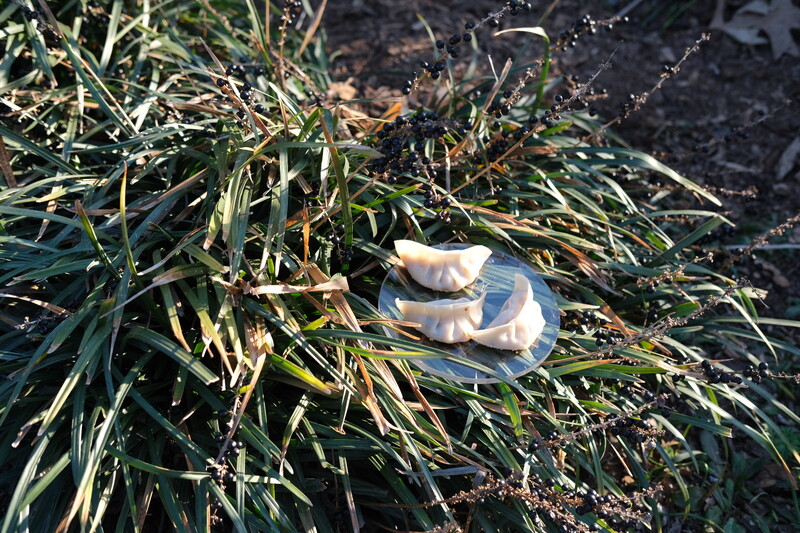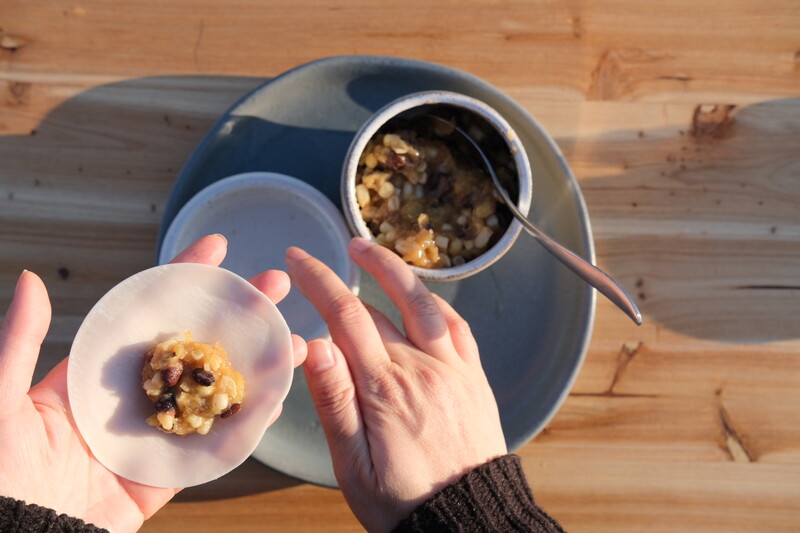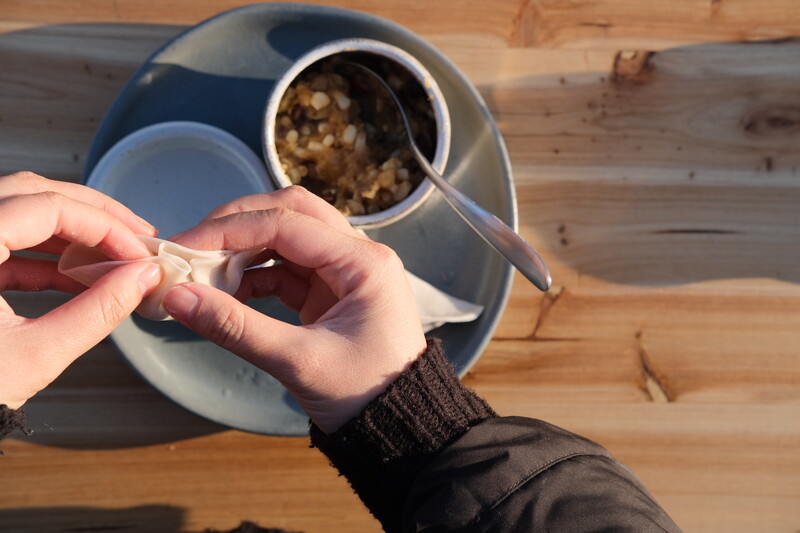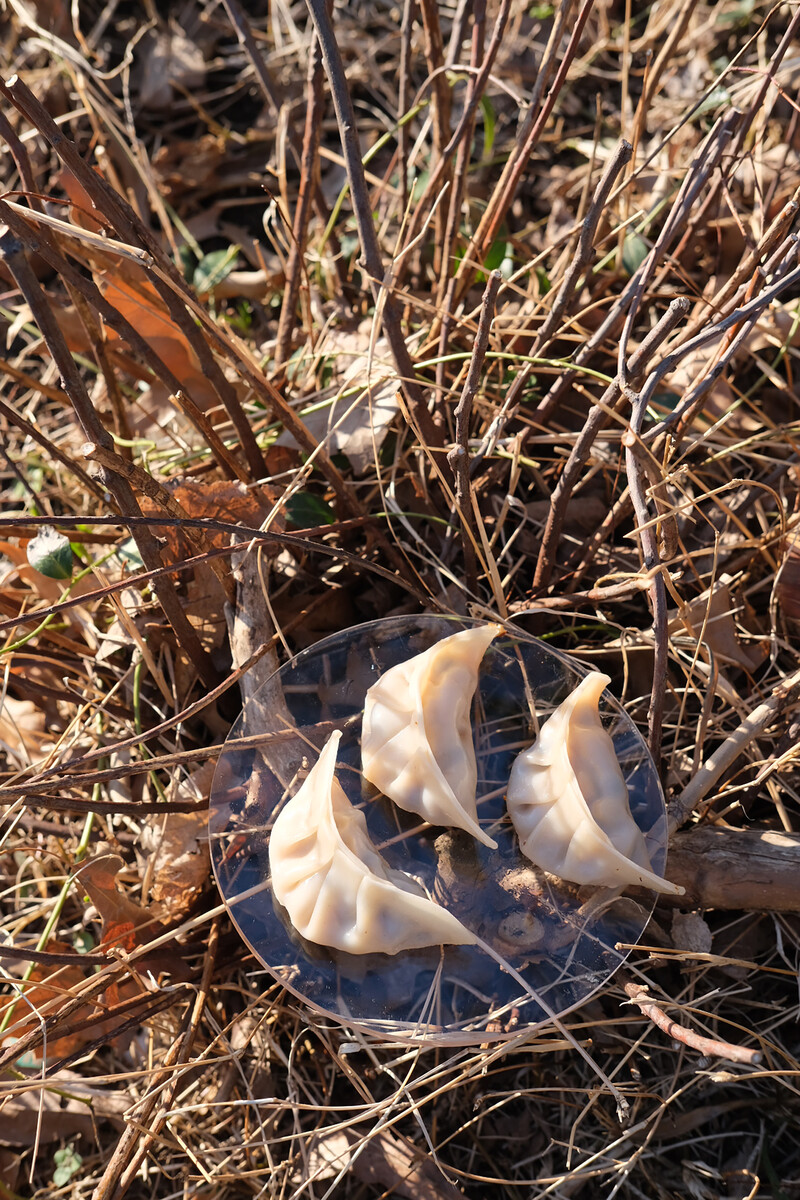- 12.0Cover
- 12.1Seams of ResilienceHangama Amiri
- 12.2How to Read this Broadsheet
- 12.3In Errors We See OurselvesTheodore (ted) Kerr
- 12.4The Pain that Bonds UsRula Kahil, Laila Omar, Neda Maghbouleh
- 12.5Undocumented: The Architecture of Migrant DetentionTings Chak
- 12.6carverCecily Nicholson
- 12.7"Holding the Door Open for Change"Tehmina Ahmad, Kori Doty, Gabrielle Griffith, A.J. Lowik, Nat Raha
- 12.8Epistolary LifelinesMercedes Eng, Kriss Li
- 12.9Palestinian Children: Art Therapy and Intergenerational TraumaRehab Nazzal
- 12.10Diasporic DumplingsAmanda Huynh
- 12.11Solidarity as a Force
Karie Liao
- 12.12Weaving to Reclaim the Bonds of Culture and LandNadia Kurd
- 12.13Glossary
Diasporic Dumplings
- Amanda Huynh
What does resilience taste like?
In the future, as we cope with climate disaster and resulting forms of migration, we will have to deeply reconsider the food that can nourish us, physically and emotionally. We will have to rely on hyper-local plant-based ingredients as a food source, while still attempting to approximate existing traditions and embodied tastes. Our bodies know the foods that are similar to those that nourished our ancestors.
Dumplings are the form we will eat—each culture has its dumpling—with the filling changing to reflect our immediate surroundings. As diasporic communities become further dispersed across the globe, the form remains our most portable and adaptable connection to our homelands. In Mississauga, dumplings can be filled with the Three Sisters: corn, beans, and squash—hardy companions that rely on each other to flourish. The Three Sisters embody a traditional growing technique of interdependent crops found in many areas of North America, carried far and wide along Indigenous foodways.
While it’s impossible to capture the love and loss I have experienced since I started making Diasporic Dumplings in 2019, I gained a lot of clarity when reflecting on the strength of my matriarchs. Kaitlin Rizarri at the Indigenous Creation Studio, University of Toronto Mississauga, suggested a Three Sisters dumpling, and it filled me with inspiration. The pieces came together immediately in my imagination and I began prototyping what ultimately became a hearty and nourishing dumpling that can be made in all seasons.
We are bound by our matrilineal lines across generations, climates, and continents.

Mississauga Diasporic Dumplings
Made in the early spring on traditional land of the Huron-Wendat, the Seneca, and the Mississaugas of the Credit.
Yields 3 dozen dumplings
½ medium cold-stored winter squash (e.g. acorn or delicata)
½ cup dried corn kernels
½ cup dried climbing beans
1 tbsp ground dried mushrooms (e.g. chicken of the woods or black morel)
Dumpling wrappers, 1 package store-bought or 1 recipe homemade (yields about 3 dozen wrappers):
2 cups all-purpose flour, plus more for rolling
pinch kosher salt
½ cup warm water
Optional dipping sauce: soy sauce, rice vinegar, chili oil, minced garlic
Dumpling Wrappers
- Put the flour in a large mixing bowl. Gradually add the water to the flour and knead with your hands until well combined, about 10 minutes.
- Cover with a damp cloth and let the dough rest for 10–15 minutes.
- Continue to knead the rested dough until it forms a smooth ball. Cover and rest again for 30 minutes. The dough will continue to soften as it rests.
- Divide the dough into 3–4 sections and, on a floured surface, roll into 2cm-diameter ropes and cut into equal pieces, about the size of the tip of a thumb.
- Use your palms to press each piece of dough into a flat circle.
- Use a small rolling pin to flatten into a thin disc by rolling from the centre of the circle to the edges and moving the disc in a circular motion as you go. With practice, the edges of the wrappers should be slightly thinner than the centre, so the dough won’t become too thick when gathered.
- Store wrappers under a damp cloth before use.

Three Sisters Filling
- Soak the corn and beans in salted water overnight. Cook the beans until tender according to the size (15–60 minutes).
- Cut open the squash, spread oil on the cut surfaces and roast until tender. Scoop out the flesh with a spoon.
- With a mortar and pestle, crush the dried mushrooms into a fine powder.
- Mix together the cooked corn, beans, and squash until evenly distributed. Season with the mushroom powder.
- Place about 1½ tsp of dumpling filling into the center of your dumpling wrappers and fold into your preferred dumpling shape. (See below for pleated dumpling instructions.)
- Dumplings can be cooked in boiling water until they float or pan-fried for a crisp texture. Serve with dipping sauce, if desired.

Pleated Dumpling Instructions
- Holding a dumpling wrapper in the palm of your hand, scoop about 1½ tsp filling into the centre.
- Dip your finger into warm water and dampen the edges of the wrapper.
- Fold the wrapper in half and pinch together the top edge to form a half-moon shape.
- On each side of the pinched edge, make two pleats starting at the centre and working your way outwards. Pinch each pleat tight before moving onto the next.
- Make sure all seams are sealed, adding a touch more water if necessary.

See Connections ⤴